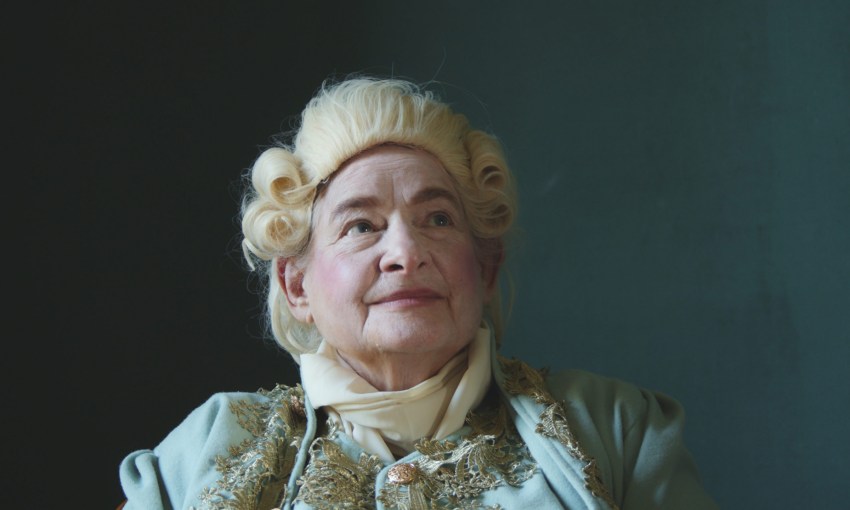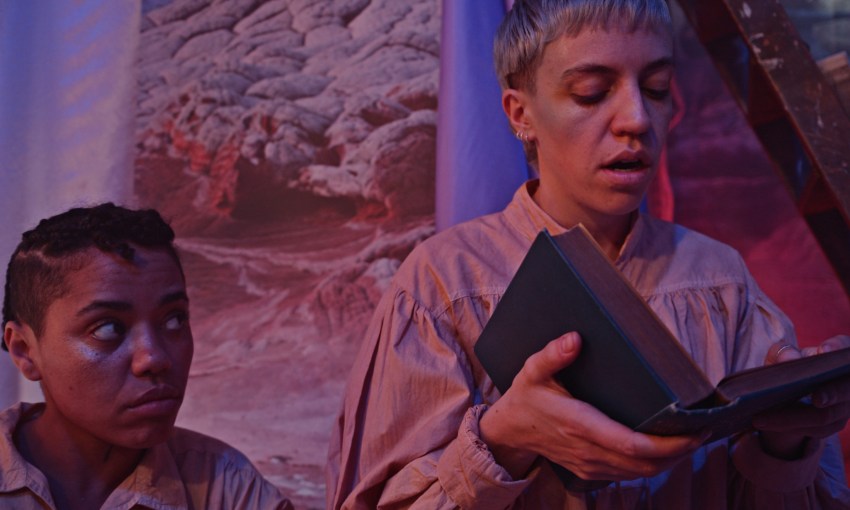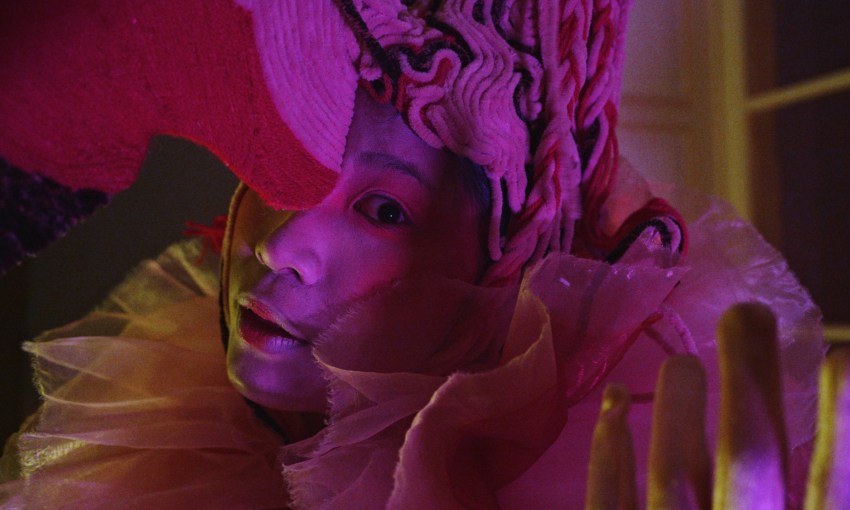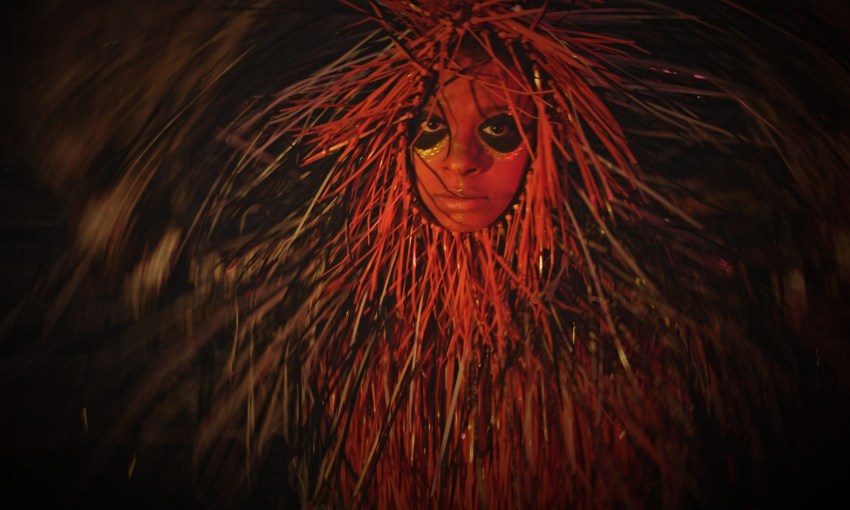In their new film 'BIOPIC or Charles Geneviève Louis Auguste André Timothée', Adelaide expat artist Madison Bycroft both does and does not portray the titular figure of French history, in a work that advocates for allowing opacity and ambiguity in our understanding of identity.
This story has no name
Inside an ornate manor, a white-wigged stately figure flips through a hard-covered book about botany.
The mise-en-scène surrounding the individual is littered with objects harking back to the 18th century: a feather quill, a globe atop a desk, and vases filled with flowers.
‘BIOPIC or Charles Geneviève Louis Auguste André Timothée’
Friday August 6—Friday October 1
Samstag Museum of Art, North Terrace Adelaide 5000
More info here.
This is the opening scene of BIOPIC or Charles Geneviève Louis Auguste André Timothée, a feature-length film by multidisciplinary artist Madison Bycroft.
The film, CityMag assumes, has one individual at its centre – the bewigged Louis.
Alas, we are mistaken.
The award-winning filmmaker explains their intention was not to create a linear biography of a single person’s life.
Charles Geneviève Louis Auguste André Timothée bursts with bizarrely beautiful sets, dream-like props, and intricately absurd costumes.
Its cast of characters includes Louis, who is the head of the manor; a trio of prophetic birds; bureaucratic bozos; and three young adults: Charlie, Lu and Andrea.
“It’s a film about storytelling, or different ways we can tell stories about characters,” says Madison, an Adelaide expat who now lives in Marseille, France.
Madison corrects our assumption of Louis as the central character by suggesting a different way of interpreting the story.
“I’m hesitant to say that it’s about that character and, in fact, I find it a little bit aggravating that there is this kind of constant need to ground something in a name,” Madison says.
“There is this necessity to draw a line around something, to give it boundaries in order to be able to name it or to point that out and also understand it.
“I’m interested in trying to imagine ways where we don’t do that.”
This, to some extent, explains the stylised strikethrough in the film’s title.
Ever curiouser, CityMag presses for an explanation of the film’s subject.
Madison offers that the film is associated with a specific historical figure: 18th century soldier, diplomat and spy, Chevalière d’Éon.
Madison requests of us, when writing about Charles Geneviève Louis Auguste André Timothée, to use the feminised French spelling of ‘Chevalière’.
This is because, contrary to formal accounts of the historical figure, “according to the memoirs, her autobiography, it’s a way that she’s self-identified,” the filmmaker explains.

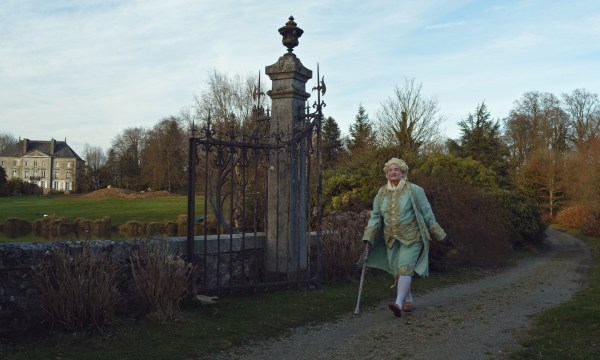
Louis on a leisurely stroll
The film cleverly separates and interrogates different parcels of Chevalière d’Éon’s personality by representing them in three individual young characters, all of whom take their name from Chevalière’s full name: Charles Geneviève Louis Auguste André Timothée.
The trio, Charlie, Lu and Andrea, venture into the manor, wherein they learn about themselves through the intriguing inhabitants they meet.
Identity is a consistent point of interest in Madison’s artistic practice.
The filmmaker is interested in the concept of opacity in identity, challenging the notion of categorisation and advocating for a right to ambiguity.
In our conversation about Charles Geneviève Louis Auguste André Timothée, CityMag is reminded of Virginia Woolf’s landmark novel Orlando: A Biography, published in 1928, which is another period drama starring a person of nobility who transitions between genders.
“I love that book,” Madison says, “and a concept from the novel features in another work I do.
“The first film [of mine] Chevaliere d’Éon is mentioned in is a film called Jolly Roger & Friends (2019), which is about not being about two other historical characters: Mary Read and Anne Bonny, who are pirates.”
These works, to Madison, are “anti-portraits”, and this artistic challenge of portraying characters while making a simultaneous effort not to portray them feels akin to chasing the strings of vitreous that float into and out of your field of vision.
“I tried to develop a mode of expression that gestured towards Mary and Anne: different fragments orbit them or perhaps touch on their edges,” Madison says.


Another white-wigged character found in the belly of the chateau
The Samstag Museum of Art, UniSA and SALA Festival commissioned Madison to develop Charles Geneviève Louis Auguste André Timothée in 2019, with financial assistance from the South Australian Film Corporation.
The work was created with a team of artists while the filmmaker was living in France and was mostly shot in a regional chateau, with some of the ornate sets built in Madison’s city studio.
Madison has flown back to Adelaide for Charles Geneviève Louis Auguste André Timothée‘s debut, and the film will show at Samstag on North Terrace from Friday, 6 August until Friday, 1 October.
Many objects seen within the film are artworks themselves, such as the peculiar tableware – hand-shaped bowls and spiral vessels.
The idea of using a film as an exhibition space for sculptural works is something Madison wants to pursue further, as it allows their other projects to bleed together.
“I think it’s a really nice format, and perhaps more accessible,” they say.
“That purpley basement space included sculptures that I’ve made over the previous year, which were initially for other exhibitions, but I work in quite an associative way and sometimes find it difficult to separate one project from another.”
For more information on how and when you can view BIOPIC or Charles Geneviève Louis Auguste André Timothée, see the Samstag website.




